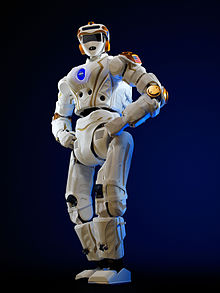Valkyrie (robot)

Valkyrie, also known as R5, is a humanoid robot developed by NASA.[1] Its design and development started in October 2012 at the Lyndon B. Johnson Space Center. The primary objective was to create a robot capable of supporting future NASA missions, whether by performing tasks in advance of human arrival on other planets or by serving as an assistant to human teams during missions.[2][3][4][5]
A prototype of the robot was completed in July 2013. Standing around 1.87 meters tall and weighing 129 kg, the robot features 44 degrees of freedom. Each of its two hands is equipped with a thumb and three fingers. Powered by three Intel Core i7 Express CPUs, it connects to external systems through Ethernet or WiFi. The battery provides roughly one hour of autonomous operation.[1][4][6][7]
At the DARPA Robotics Challenge Trials in December 2013, the participating Valkyrie robot failed to score any points, with a network problem being reported as the cause.[2]
The robot was used in a simulation for the Space Robotics Challenge.[8]
In mid-2015, NASA announced plans to provide two R5 robots to research teams. The competition was won by the Massachusetts Institute of Technology (MIT) and Northeastern University, with each team receiving an R5 robot along with $500,000 in funding spread over two years.[9][10][11]
References
[edit]- ^ a b "R5 - NASA". 2015-09-23. Retrieved 2024-09-10.
- ^ a b "What Happened to NASA's Valkyrie Robot at the DRC Trials, and What's Next". IEEE Spectrum. Retrieved 2024-09-10.
- ^ "NASA Wants Help Training Valkyrie Robots to Go to Mars". IEEE Spectrum. Retrieved 2024-09-10.
- ^ a b Radford, Nicolaus A.; Strawser, Philip; Hambuchen, Kimberly; Mehling, Joshua S.; Verdeyen, William K.; Donnan, A. Stuart; Holley, James; Sanchez, Jairo; Nguyen, Vienny; Bridgwater, Lyndon; Berka, Reginald; Ambrose, Robert; Myles Markee, Mason; Fraser‐Chanpong, N. J.; McQuin, Christopher (May 2015). "Valkyrie: NASA's First Bipedal Humanoid Robot". Journal of Field Robotics. 32 (3): 397–419. doi:10.1002/rob.21560. ISSN 1556-4959.
- ^ "Prepping a robot for its journey to Mars". Massachusetts Institute of Technology. 2016-10-18. Retrieved 2024-09-11.
- ^ Kramer, Miriam (2013-12-11). "Meet Valkyrie: NASA's Superhero-Like Walking Robot Unmasked". Space.com. Retrieved 2024-09-10.
- ^ "NASA unveils 6-foot 'superhero robot' Valkyrie". CNET. Archived from the original on 2013-12-11. Retrieved 2024-09-11.
- ^ "How a One-Man Team From California Won NASA's Space Robotics Challenge". IEEE Spectrum. Retrieved 2024-09-11.
- ^ "NASA Awards R5 Valkyrie Robots to MIT and Northeastern". IEEE Spectrum. Retrieved 2024-09-10.
- ^ "This Valkyrie R5 humanoid robot is put to the test with Mars colonization on the horizon". FoxNews. 2017-03-19. Retrieved 2024-09-10.
- ^ Heater, Brian (2017-03-18). "In a Massachusetts warehouse, NASA's Valkyrie robot helps lay the groundwork for Mars settlements". TechCrunch. Retrieved 2024-09-11.
External links
[edit]- IEEE Spectrum (2013-12-10). Valkyrie: NASA's Superhero Robot. Retrieved 2024-09-10 – via YouTube.
- "Photos: NASA's Valkyrie R5 Space Robot in Pictures". Space.com. 2014-01-20. Retrieved 2024-09-10.
